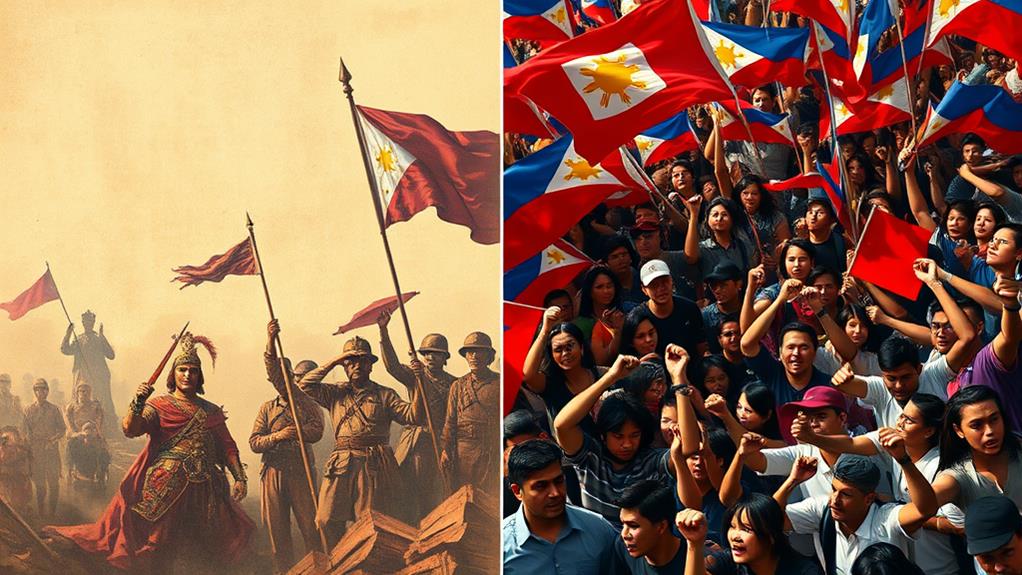The Philippines has a complex democratic history shaped by centuries of colonial rule, revolution, and ongoing struggles for self-governance.
In 1946, the country gained independence from the United States, marking a significant milestone in its democratic evolution. During the American colonial period, democratic principles were introduced, and the 1935 Constitution reflected U.S. democratic ideals.
Post-war developments saw social movements advocating for economic nationalism and resisting foreign dominance.
To develop a more democratic government, electoral reforms were implemented, including single-term limits for presidents.
Despite ongoing challenges like corruption, electoral fraud, and dynastic politics, the Philippines continues to grapple with its democratic identity.
Historical Foundations of Democracy
The American colonial period laid the groundwork for democracy in the Philippines. During this time, the Philippine Organic Act of 1902 established a national government and legislative body, introducing democratic principles to the islands.
This foundation was further solidified with the 1935 Constitution, which reflected U.S. democratic ideals and inaugurated the Commonwealth of the Philippines.
Political parties emerged between 1917 and 1935, marking the acceptance of opposition in the political system. The Nacionalista and Liberal parties dominated the landscape during this period.
The Tydings-McDuffie Act of 1934 set a timeline for Philippine independence. This act established a Commonwealth government and paved the way for a ten-year transition to full sovereignty.
The Philippines gained independence on July 4, 1946. This historical groundwork ultimately led to the Philippines achieving independence, although significant U.S. influence continued to shape the country's political and economic structures.
Colonial Legacy and Governance
The Legacy of Colonial Governance in the Philippines
Colonial Rule Shaped the Country's Political Landscape
When the Philippines gained independence, the legacy of colonial governance had a lasting impact on the country's political landscape. The transition from pre-colonial governance structures to a centralized Spanish colonial administration significantly altered local power dynamics and introduced Catholicism.
For example, the Spanish colonization led to the replacement of traditional Filipino leaders with Spanish governors and the establishment of a hierarchical system of government.
American Colonization Introduced New Governance Models
Under American colonization, the Philippine Organic Act of 1902 established a national government and legislative body, mirroring U.S. governance models. This expanded political participation among local elites, who were mostly educated in American-style schools and adopted American political ideologies.
The 1935 Commonwealth inaugurated a U.S.-style constitution, emphasizing limited state power and facilitating the establishment of a two-party system dominated by elite interests and ongoing colonial influences.
The Lasting Impact of Colonial Legacy on Philippine Democracy
The colonial legacy has had a lasting impact on Philippine democracy, as political institutions and practices often favor elite control and hinder equitable wealth distribution.
This has contributed to ongoing social and political challenges, such as poverty, inequality, and political instability.
Today, the Philippine Government still grapples with the consequences of colonial rule, striving to establish a truly representative democracy that benefits the entire nation, not just a select few.
National Identity and Revolution

National Identity and Revolution
In the late 19th century, Filipinos sought national identity and self-governance, challenging Spanish colonial rule. The Propaganda Movement, led by the Ilustrados, advocated for reform and greater autonomy within the Spanish colonial system. This movement fostered a sense of national identity among Filipinos, laying the groundwork for future revolutionary efforts.
Key Events:
| Event | Description |
|---|---|
| Propaganda Movement (1880s) | Advocated for reform and greater autonomy within the Spanish colonial system |
| Katipunan Formation (1892) | Sought complete independence from Spanish rule |
| José Rizal's Execution (1896) | Intensified anti-Spanish sentiments and catalyzed revolutionary efforts |
| Declaration of Philippine Independence (1898) | Marked a pivotal moment in the establishment of a national identity |
| Philippine-American War (1899-1902) | Highlighted the complexities of national identity and self-governance |
The Philippine Revolution, led by Emilio Aguinaldo, transitioned from fighting Spanish colonial rule to resisting American colonial rule in the Philippine-American War. This complex and tumultuous era shaped the country's quest for national identity and self-governance, setting the stage for the country's future democratic developments.
Post-War Developments and Challenges
The Philippines gained independence in 1946, but it was followed by a period of significant political instability and economic challenges.
The country required extensive rehabilitation aid from the United States to rebuild after the war. The Bell Act established a free trade agreement for eight years, followed by 20 years of increasing tariffs, which highlighted the continued economic influence of the U.S. in the Philippines.
During this time, social movements emerged, advocating for economic nationalism and resistance against foreign dominance. This led to a growing sense of Filipino identity.
In 1953, Ramon Magsaysay was elected, marking a shift towards charismatic leadership. He aimed to implement social and economic reforms, despite facing opposition from the legislature.
However, the political landscape remained unstable after Magsaysay's death in 1957, with ongoing issues of land reform and poverty persisting despite changes in leadership and governance.
Throughout this period, the Philippines' democratic government faced numerous challenges in establishing a stable and independent political system.
Electoral Dynamics and Evolution

The Evolution of Electoral Dynamics in the Philippines
The transition to American rule in 1898 marked the beginning of electoral dynamics in the Philippines, introducing local elections and establishing a political framework. This framework was further developed through the Philippine Organic Act of 1902, which facilitated the first provincial elections and allowed for increased participation of local elites in governance.
Key Milestones in Electoral Evolution
The 1916 Jones Law replaced the Philippine Commission with a Senate and expanded the voting franchise by removing property ownership requirements, increasing the electorate to 6-7% of the population.
Between 1917 and 1935, political parties formed, with the Nacionalista and Liberal parties dominating the landscape, reflecting elite interests and the increasing acceptance of opposition.
Significant Electoral Reforms
The 1987 Constitution introduced significant electoral reforms, including a single-term limit for presidents and a multi-party system, aiming to enhance democratic participation amidst political instability.
These events have collectively contributed to the development of a democratic government, paving the way for national elections that reflect the will of the people.
Contemporary Political Landscape
The Philippines' political landscape is complex and multifaceted. It features a multi-party system, with the Liberal Party and Nacionalista Party being the most prominent, reflecting the enduring influence of the political elite.
The 1986 People Power Revolution led to significant changes. A new constitution was established, introducing a single-term limit for presidents to prevent the concentration of power.
Despite these reforms, political instability persists. Corruption, electoral fraud, and dynastic politics continue to affect democratic processes.
Examples include the manipulation of votes and the dominance of political families in government positions.
Security challenges also exist. The ongoing presence of armed groups, such as Muslim separatists and communist insurgents, complicates governance and stability in the region.
These groups have been involved in violent conflicts and kidnappings.
Recent administrations have faced criticism. President Rodrigo Duterte's controversial war on drugs has drawn international scrutiny over human rights violations, including extrajudicial killings and enforced disappearances.
The country's democratic processes are still grappling with these challenges. Addressing these issues is crucial to ensuring the stability and development of the Philippines.
Questions and Answers
What Are the Stages of the Evolution of Politics and Governance in the Philippines?
The Philippines' evolution of politics and governance unfolded in distinct stages.
Pre-colonial governance structures existed in the Philippines before the arrival of Spanish colonizers. These structures were replaced by a centralized system under Spanish rule, which lasted from 1521 to 1898.
American colonization introduced a national government framework from 1898 to 1935. This period saw the establishment of a formal government structure, including a senate and a house of representatives.
The Commonwealth period, from 1935 to 1946, marked a significant shift towards self-governance. The Philippines was granted greater autonomy, with a president, vice president, and a unicameral national assembly.
Post-World War II, the country faced instability and power struggles. This period saw the rise and fall of various governments, including the regime of President Ferdinand Marcos.
The 1986 People Power Revolution marked a significant turning point towards democracy. This event led to the ousting of President Marcos and the restoration of democratic institutions.
Throughout these stages, foreign powers and elite control have shaped the country's governance, influencing its political development.
When Was the Restoration of Democracy in the Philippines?
The restoration of democracy in the Philippines took place on February 25, 1986.
This significant event followed the People Power Revolution, a peaceful uprising that led to the ousting of President Ferdinand Marcos.
During this time, millions of Filipinos gathered on EDSA to demand an end to his authoritarian regime.
This marked a turning point in the country's history, paving the way for a new era of democracy.
What Is the Democracy Movement in the Philippines?
The democracy movement in the Philippines is a collective effort to establish and maintain a government that represents the people's interests.
This movement encompasses various groups and events that have fought for reforms, independence, and self-governance.
One notable example is the Propaganda Movement, which emerged in the late 19th century and sought to reform the Spanish colonial government.
Filipinos have tirelessly pushed for democratic values, facing challenges along the way.
The People Power Revolution in 1986 is a prime example, where millions of Filipinos gathered to protest the Marcos regime, ultimately leading to its downfall and the restoration of democracy.
Today, the Philippines is still striving for a more perfect democracy.
Despite ongoing challenges, the country continues to work towards strengthening its democratic institutions and upholding the principles of freedom, equality, and justice.
What Is the Current State of Democracy in the Philippines?
The Philippines operates under a presidential system, where the president serves as both head of state and head of government. However, power remains concentrated among elite families, limiting genuine representation and perpetuating social inequality.
Despite high voter turnout, the country faces challenges to its democratic governance. Corruption is a significant issue, with the Philippines ranking 113th out of 180 countries in the 2020 Corruption Perceptions Index.
Human rights violations also persist, with reports of extrajudicial killings, enforced disappearances, and torture.
Additionally, insurgent groups pose a threat to national security, with the communist New People's Army and the Islamist Abu Sayyaf Group being among the most prominent.
The country also experiences a mix of populist leaders and authoritarian tendencies, which can undermine democratic institutions and principles.
To ensure a more effective and inclusive democracy, it's essential to address these underlying problems. This includes promoting transparency and accountability, protecting human rights, and addressing the root causes of insurgency and social unrest.